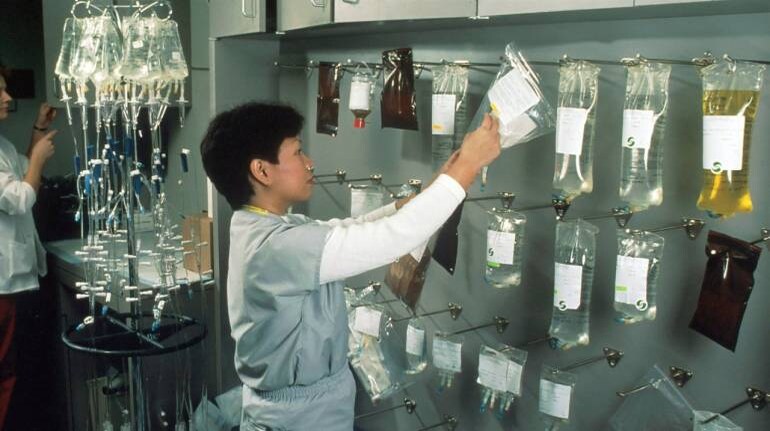



Earlier this month, IIT Bombay-incubated firm ImmunoACT said it had received approval from the Central Drugs Standard Control Organization (CDSCO) for its CAR-T cell cancer therapy NexCAR19 (actalycabtagene autoleucel) for the treatment of certain types of lymphomas and leukemias.
Millions of new cancer cases are reported globally every year. Cancer is possibly the most formidable issue in the field of medicine and health. However, with advancing technology, scientists have developed various treatment modules to combat several resilient and severe forms of cancer. One such treatment option is Chimeric Antigen Receptor T cell (CAR-T cell) therapy, which can be used for the treatment of lymphomas and leukemia. Let’s learn more about this therapy and how it can benefit those suffering from cancer.
What is CAR T-cell Therapy?
Our immune system consists of billions of cells such as lymphocytes, neutrophils, and monocytes, which fight against various infections. Lymphocytes have 3 subtypes;
- B lymphocytes (B-cells): Produces antibodies against infections
- T lymphocytes (T-cells): Eradicates infected cells and helps form B cells
- Natural killer cells: Kills infected cells
Chimeric antigen receptor (CAR) T-cell therapy, commonly called CAR T-cell therapy, genetically modifies the T-cells, thus making them more potent against the cancer cells present in the body.
How is CAR T-cell therapy given?
The process of CAR T-cell therapy includes the following steps:
- Blood is drawn from the arm of the patient. After removing white blood cells (WBCs), the blood is put back into the patient’s body.
- T cells are separated from the white cells and sent to the lab for the addition of the gene specific to the chimeric antigen receptor (CAR).
- This forms CAR T-cells, which are grown and multiplied in the lab for several weeks.
- After a sufficient amount of CAR T-cells are produced, they are given to the patient. In most cases, the patient is given chemotherapy before the CAR T-cell infusion, to lower the immune response towards the new immune cells.
What cancers can be treated with CAR T-cell therapy?
CAR T-cell therapy is mostly used for patients with blood cancer, who don’t respond to any other forms of treatment including chemotherapy. It is basically used to treat leukaemias and lymphomas.
1. Leukaemia
Leukaemia is a type of blood cancer, which is marked by rapid, uncontrollable growth of abnormal white blood cells. It mainly affects the bone marrow, thus hampering its ability to produce blood cells and platelets and combat infections. CAR T-cell therapy is widely used to treat acute lymphocytic leukaemia (ALL), which is a type of leukaemia that is more commonly seen in children than adults. Notably, CAR T-cell therapy has shown a full recovery of up to 92 percent in end-stage ALL patients.
2. Lymphoma
Lymphoma is a cancer that affects the lymphatic system of the body. The lymphatic system comprises the tissues, vessels and organs that fight against infections. Lymphoma starts in the WBCs of the lymphatic system, hence it is considered a blood cancer. The two types of lymphoma include Hodgkin lymphoma and non-Hodgkin lymphoma. CAR T-cell therapy involving the targeting of CD19 antigen has shown promising results in patients with certain types of relapsed (reappeared form of cancer) or refractory (a cancer that continues to grow) large B-cell lymphoma.
What are the side effects of CAR T-cell Therapy?
The most common side effects of CAR T-cell therapy include:
1. Cytokine release syndrome (CRS)
This is a potentially serious side effect of CAR-T cell therapy. A large amount of cytokines (chemical messengers) are produced when the CAR-T cells multiply and fight the cancer in the body. This may cause the patient to experience symptoms like nausea, fatigue, diarrhoea, fever with/without chills and headache. However, the more severe symptoms of CRS may include:
- Abnormally high heart rate (tachycardia)
- Low blood pressure
- Heart problems such as cardiac arrhythmias, heart failure and even cardiac arrest
- Lack of enough oxygen reaching the body (hypoxia)
- Kidney problems
- Multiple organ failure
These signs could be seen within 1 to 21 days of CAR-T cell infusion and would require intensive care treatment.
2. Neurological symptoms
CAR-T cell therapy can affect the nervous system of the body and result in the following symptoms within the first week of infusion:
- Headache
- Difficulty speaking
- Feeling agitated
- Difficulty balancing
- Tremors or seizures
Apart from these two major side-effects, the patients may experience allergic reactions, weakened immune system, or low blood cell count post CAR-T cell infusion.
Is CAR-T cell therapy expensive?
Despite being an innovative and promising treatment for cancer, CAR-T cell therapy is expensive. The reasons may include:
- The manufacturing process of the medication is complex.
- The medication is customized for each patient on the basis of their immune response and type of cancer.
- The therapy undergoes several clinical trials and regulatory compliance before getting approval for clinical use.
- Due to its potential side-effects, the therapy requires long-term follow-up.
ImmunoACT'sNexCAR19 therapy is expected to cost Rs 30-40 lakh per patient - reportedly a tenth of what it would cost to get this therapy abroad.
Conclusion
CAR T-cell therapy is a groundbreaking treatment for patients who either don’t respond to chemotherapy or have relapsed cancer. However, given the high cost of treatment and potential side effects, one must consult with their oncologist to determine if they should opt for CAR T-cell therapy.
Discover the latest Business News, Sensex, and Nifty updates. Obtain Personal Finance insights, tax queries, and expert opinions on Moneycontrol or download the Moneycontrol App to stay updated!
Find the best of Al News in one place, specially curated for you every weekend.
Stay on top of the latest tech trends and biggest startup news.